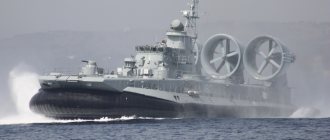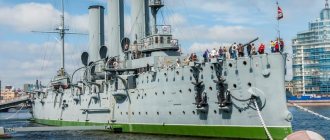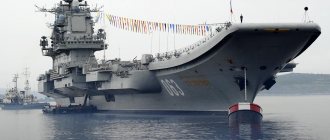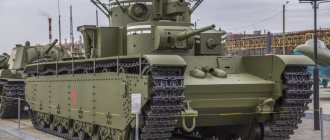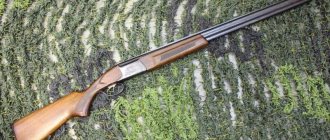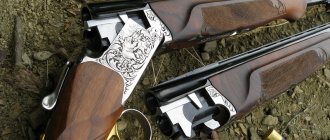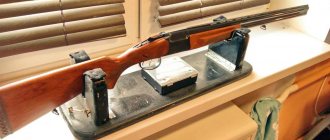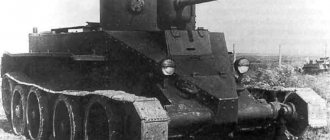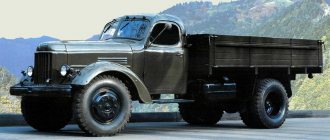The advantage of hovercraft (HFV, SVP) is minimal or no draft. This allows ships to move not only in shallow water, but also on ground or ice, overcoming small areas of land. In addition to the properties of an amphibian, the shallow draft provides the ship with high speed.
The idea of such a design was first voiced at the beginning of the 18th century; technologies for implementation appeared at the end of the 19th century. Prototypes of hovercraft appeared only in the first half of the 20th century. Today, for military purposes, such ships are used for landing, mining, and delivery of cargo and equipment.
Project 12322 “Zubr” is a Soviet small landing hovercraft (MDK, MDVKP). Designed for delivery and evacuation of infantry and equipment from equipped or unequipped shores.
Armament
A-22 "Fire" SAM launcher
A-22 "Fire"
Shots for A-22 "Fire"
140-mm multiple launch rocket system - flamethrower-incendiary complex. The system was created and produced by SNPP “Splav” (Tula) and is intended for arming river and landing ships, as well as hovercraft.
Guidance – optical sight “Shelon-14” (rangefinder-sighting device – DVU-3-BS, weight 300 kg). The rangefinder and sighting device is designed for remote control of the complex’s firing at coastal and surface targets, as well as for searching and detecting targets in daylight and dark, subject to their meteorological visibility. DVU-3-BS ensures the generation of full horizontal and vertical guidance angles and their automatic transfer to the launcher.
Launcher - MS-227, 22 barrels, stowed under deck in stowed position, manual reloading.
Dimensions (LxWxH) 2125 mm x 1735 mm x 2200 mm
Vertical guidance angle – from -10 to +65 degrees Horizontal guidance angle – sector 320 degrees Launcher weight – 1430 kg (without ammunition), 1700 kg with ammunition Complex weight: – without/with ammunition – 2000 kg/2600 kg
Performance characteristics of the artillery unit:
Projectile caliber – 140 mm PU barrel caliber – 140.3 mm
Range of action – 800-4500 m Projectile speed at the muzzle – 27-40 m/s Projectile speed at the end of the active section – 400 m/s Maximum carrier speed when firing – up to 30 knots Reaction time of the complex – 8 s Sea roughness when firing – up to 3 points Operating temperature – from -40 to +50 degrees C
30mm automatic installations type AK-630
AK-630
AK-630 device
30-mm six-barreled automatic naval artillery mount, created under the leadership of V.P. Gryazev and A.G. Shipunov. In the name “6” means 6 barrels, 30 is the caliber. It is a means of self-defense for ships and can be used to destroy air targets at slant ranges up to 4000 m and light enemy surface forces at distances up to 5000 m.
Fire characteristics:
Caliber: 30 mm Cartridge: 30×165 mm Barrel length: 54 caliber Rate of fire: 4000-5000 rds/min
Queue length:
6 bursts of 400 shots with a break of 5 s 6 bursts of 200 shots with a break of 1 s Cartridge weight: 0.83 kg Initial projectile speed: 1030 m/s Firing range: 4000 m
Vertical plane: -12 to +88 deg Maximum traverse speed in the vertical plane: 50 deg/sec Horizontal plane: +180 to -180 deg Maximum traverse speed in the horizontal plane: 70 deg/sec
Other characteristics:
Weight: 3800 kg
Ammunition supply system: belt, continuous Combat crew: 1 person. Ammunition: main - 2000 units, spare bunker - 1000 units. (only for AK-630M)
Igla missile system
"Igla" (GRAU index - 9K38, according to the US and NATO classification - SA-18 Grouse
(Russian: Scottish Partridge)) is a Russian/Soviet man-portable anti-aircraft missile system designed to destroy low-flying air targets on oncoming and catch-up courses under conditions of exposure to false thermal interference. The complex was put into service in 1983.
Communications, detection and control
For navigation tasks and navigation safety in the entire range of speeds, the Zubr is equipped with an integrated navigation system, a GKU-2 gyro direction indicator, a KM-60-M2 magnetic compass, an RDL-3-AP100 radio Doppler drift logger, a radio direction finder, a central gyroscopic system "Baza", a navigation RS-1 radar and satellite navigation equipment.
The ship can also receive, transport mines and lay active minefields. The possibility of receiving and setting 20-80 (depending on type) minutes is provided. The Zubr is equipped with an automated radio communication complex Buran-6, which provides communication with surface ships and coastal control posts in the KB, MB and UHF bands in telephone and telegraph modes.
Landing
Troop compartment
The amphibious air-cushion landing ship of Project 12322 "Zubr" can take on board military equipment and personnel of the advanced detachments of amphibious assault forces from an equipped or unequipped coast, transport them by sea, land them on an unequipped coast and support the landing with fire.
The landing compartment of the Zubr can accommodate three medium tanks of the T-80B type (T-72A, T-64B, T-62) or 10 light armored fighting vehicles (BTR-80, BTR-70 or BTR-60PB), or from 360 to 500 paratroopers.
In addition, the ship could transport by sea up to 8 BMP-1 (BMP-2) infantry fighting vehicles or PT-76B light tanks. There is also an option for transporting equipment and 140 paratroopers.
Design
Ship model
Ship's armament: MS-227 missile launchers visible
The air cushion superchargers and propellers on the ship are driven by an M35 unit with a total capacity of 50,000 hp. With. produced by the State Enterprise “Research and Production Complex for Gas Turbine Construction “Zorya” - “Mashproekt”. The air cushion is formed by 4 NO-10 injection units with an axial impeller with a diameter of 2.5 m. The creation of thrust for the movement of the vessel is carried out by three 4-blade reversible propellers with forced pitch control. Screws with a diameter of 5.5 m are installed in ring nozzles made of polymer composite materials produced by KTB Sudocomposite. Project 12322 ships have two power plants, consisting of two gas turbine generators with a capacity of 100 kW each and main switchboards. The movement of the ship and its technical means are controlled centrally, remotely and using automation elements. It is carried out from the main command post, central control post and remote control panels.
The hulls of small landing ships are made of all-welded high-strength, corrosion-resistant aluminum-magnesium alloy. The main load-bearing part of the ship's hull, which ensures the strength and unsinkability of the vessel, is a rectangular pontoon. The superstructure located on the pontoon is divided by two longitudinal bulkheads into 3 functional compartments. In the middle part there is a landing equipment compartment with tank tracks and ramps. The onboard compartments house the main and auxiliary power plants, quarters for the personnel of the landing groups, living quarters, life support systems and protection against weapons of mass destruction. The flexible air cushion fence is designed to hold the air cushion under the ship's hull and to ensure the required height of the ship above the supporting surface (clearance). The fencing is made of two tiers: with a flexible receiver and hanging elements - with cross-shaped sectioning of the air cushion with longitudinal and transverse keels. To maintain comfortable conditions at combat posts, in the landing premises and crew living quarters, ventilation, air conditioning, heating systems, heat and sound insulating coatings, structures made of vibration-damping material are provided, and normal conditions for rest and nutrition for the crew are created.
Literature and sources of information
Literature
Ships of the USSR Navy. Handbook in four volumes. Volume IV. Landing and mine-sweeping ships. St. Petersburg: “Galeya Print”, 2007. - 188 pp., ill.
Links
- https://nevskii-bastion.ru/12322/
- https://topwar.ru/6675-zubr-samyy-bolshoy-korabl-na-vozdushnoy-podushke.html
- https://korabley.net/news/2009-01-28-149
- https://knigarekordovrossii.ru/index.php/rekordy/kategorii/tekhnika/833-krupnejshee-sudno-na-vozdushnoj-podushke.html
- https://skuky.net/79510
- https://www.odnako.org/blogs/dobro-pobezhdaet-kak-kiev-ukral-u-rossii-zubra-i-chto-iz-etogo-vishlo/
Alternative landing concepts
A vehicle with a wheeled or tracked undercarriage can move on land and overcome difficult obstacles, but the height range of obstacles is limited. There are armored vehicles capable of swimming, but their navigability usually does not correspond to the concept of a “ship”; they are slow-moving and relatively helpless until they enter the shore. There are special-purpose warships designed to transport and land troops, which may include several units of armored vehicles and manpower. These watercraft also have disadvantages: they are vulnerable due to their low speed, and they require a suitable shore to successfully complete a combat mission. Only 14% of all beaches are suitable for landing with water-displacement type MDC (an abbreviation for small landing craft), mooring closely and opening ramps.
There is another concept developed in recent decades. This is an over-the-horizon landing. Its essence is that the main ship is located far from the coast, and the delivery of armored vehicles is carried out by special self-propelled small vessels. The Mistral class helicopter carriers are ready for this kind of landing. Landing in this way is, of course, only possible under conditions of complete dominance of land, air and water. What will happen to the landing force if the enemy has effective countermeasures (coastal defense systems, for example) can be easily imagined. It will serve as food for fish.
The Zubr landing ship is fast, it does not stop on the shore, its firepower itself poses a danger to enemy defenses. In general, this is an almost ideal landing tool. It can serve 78 percent of the world's sea and ocean coastlines.
Main purpose
The ships are designed to receive amphibious assault units with military equipment from an equipped or unequipped shore, transport them by sea, land on the enemy’s coast and fire support for landing troops. In addition, they can transport mines and lay minefields.
Thanks to the design features of the air cushion, it can move on the ground, avoiding small obstacles (ditches and trenches) and minefields, move through swamps and land troops deep in enemy defenses. For the Zubr MDKVP, up to 70% of the total length of the coastline of the world's seas and oceans is available for landings.
Composition of the series
| Name | Inducted into the fleet | Manufacturer | Current status | |
| MDK-51 | 100 | 10.10.1988 | Primorsky Shipyard | Disposed of |
| MDK-122 | 101 | 02.01.1990 | Primorsky Shipyard | Disposed of |
| MDK-50, from 08/17/2001 - “Evgeniy Kocheshkov” | 102 | 30.10.1990 | Primorsky Shipyard | As part of the Russian Baltic Fleet, it underwent repairs in 2013-2014 |
| MDK-94, from 03/12/2001 - “Mordovia” | 103 | 15.10.1991 | Primorsky Shipyard | Under repair. As part of the Russian Baltic Fleet. |
| MDK-118, from 12/20/2000 - “Kefallonia” L180 | 104 | 29.08.1994 | Primorsky Shipyard | In service, Hellenic Navy |
| MDK-119 | 105 | — | Primorsky Shipyard | Not completed |
| MDK-120 | 106 | — | Primorsky Shipyard | Not completed |
| "Kerkyra" L182 | 107 | 28.05.2001 | Primorsky Shipyard | In service, Hellenic Navy |
| "Zakynthos" (Kakynthos) L183 | 108 | 25.07.2004 | Primorsky Shipyard | In service, Hellenic Navy |
| MDK-57, since 1995 - “Kramatorsk” (Kramatorsk) U422 | 301 | 30.12.1988 | Shipbuilding | Disposed of |
| MDK-123, since 1995 - “Artemovsk” (Artemivsk) U424 | 302 | 30.12.1989 | Shipbuilding | Disposed of |
| MDK-93, "Gorlovka" (Gorlivka) | 303 | 30.12.19912015 | Shipbuilding | Chinese Navy |
| MDK-100, "Donetsk" (Donetsk) U420 | 304 | 26.06.1993 | Shipbuilding | Disposed of |
| “Ivan Bogun” (Ivan Bogun) U421, “Ithaki” (Ithaki) L181 | 305 | 03.02.2001 | Shipbuilding | In service, Hellenic Navy |
| 3325 | 306 | ~03.2014 | Shipbuilding | In service, Chinese Navy |
| 3326 | 307 | 28.12.2015 | Shipbuilding | In service, Chinese Navy |
| 3327 | 308 | Shipbuilding | In service, Chinese Navy |
Notes
- "Zubr" is the largest hovercraft in the world.
- Construction of Zubr ships for the Russian Navy may be resumed in Feodosia
- Flying ships will be built for sailors
- Shipbuilders: “Bisons” for the Navy will begin to be built no earlier than 2019-2021
- Ukraine has begun fulfilling a contract with China for the supply of 4 Zubr ships
- China may be left without Ukrainian amphibious hovercraft. 7.4.2014
- FSK "MORE" WILL COMPLETE THE PRODUCTION OF MDC "BIZON" FOR THE PRC (VIDEO) (unspecified)
(inaccessible link). Access date: September 21, 2012. Archived May 22, 2014. - China bought from Greece
- Re-laid under Project 958 “Bison” for the Chinese Navy
Armament and transport characteristics
Landing of equipment with infantry
Taking into account the purpose of the Zubr vessel, attention is paid not only to its driving performance, but also to its landing capacity. The likelihood of supporting the landing with our own weapons is also taken into account, as well as the need for self-defense against possible attacks.
Landing
The number of troops transported depends on the loaded equipment. The total carrying capacity of the ship is 150 tons. In the absence of combat vehicles and tanks, the ship is capable of carrying up to 500 people. In other cases, it all depends on the load.
Tanks, armored personnel carriers, infantry fighting vehicles
Landing of equipment is carried out in several ways:
- three main tanks with a total weight of up to 150 tons;
- 10 armored personnel carriers weighing up to 131 tons and 140 landing personnel;
- 8 infantry fighting vehicles weighing up to 115 tons with escort;
- 8 amphibious tanks.
MS-227 "Fire"
The Zubr's artillery armament is represented by two A-22 (MS-227) "Fire" launchers. These systems are designed to hit targets with 140 mm caliber unguided missiles. There is a fire control system. Ammunition for each installation is 66 rounds.
Two automatic 30 mm cannons
Two AK-630 mounts are used as anti-aircraft artillery. Each has 6 barrels with a caliber of 30 mm. Ammunition - 3000 shells. They can fire at air, ground or surface targets. Control system - MR-123-02. Additionally, there are 8 Igla or Stinger man-portable anti-aircraft missile systems on board.
Combat use
Despite the long period of service, the Zubr hovercraft were not used in combat conditions. Since being put into service, the ships have regularly participated in ongoing landing exercises. The latter took place in the Baltic Fleet. In addition to the landing of BTR-82 and assault marine units, artillery firing was also practiced.
Based on the results of the exercises, a decision was made to modernize the two Zubrs in the fleet - MDKVP Mordovia and Evgeniy Kocheshkov, as well as to build new ships of this type. It is planned to install new navigation systems, update weapons, communications and control equipment. There is no exact information yet about the timing of construction and modernization; the guideline is set for the early 2020s.
Design
Trial operation of the lead ship made it possible to identify all the shortcomings and correct them in subsequent production ships of the project. On serial MDKs, defensive armament was strengthened (two 30-mm AK-230 installations with a Lynx fire control radar were installed) and habitability conditions were improved, and the ship's hull itself, instead of being riveted, was made of welded AMG-61 alloy.
The cargo compartment has a through passage for equipment and is located near the center plane. Service compartments are spaced along the sides. At full speed, the Jeyran landing ships are controlled by air rudders located behind the propulsors, and at low speeds by jet rudders with air bleed from axial blower fans. The main thrusters are four-blade adjustable pitch propellers with a diameter of 3.5 meters.
The total displacement of the Jeyran ships reached 353 tons, the full speed was 50 knots, the cruising range was 300 miles, and the endurance was 5 days. The main power plant of this small landing ship consisted of two DT-4 gas turbine engines with a total power of 32,000 hp. s., driving superchargers and four propellers.
Project history
By the end of the 1970s, Soviet designers had quite a wealth of experience in building hovercraft. By 1970, ships of the Skat, Kalmar and Project 12321 Jeyran projects were launched into series.
To develop the concept of military hovercraft, in 1978 the Navy command tasked TsMKB Almaz to create a more powerful landing ship. The design bureau began work, naming the project 12322 under the code “Bison”. The plan included an increase in speed, landing load, and artillery and electronic weapons. The project, which became the development of the Dzheyrans, was headed by chief designers L.V. Ozimov, Yu.M. Mokhov and Yu.P. Semenov, under the supervision of Captain 2nd Rank V.A. Litvinenko (later Captain 2nd Rank Yu.N. Bogomolov) from the Navy. The original layout of the ship was the merit of Deputy Chief Designer G. D. Koronatov, who developed the preliminary design.
The lead MDKVP, number MDK-95, was experimental and built in 1986 and, after extensive testing, entered service with the Navy in 1988. Based on the results of these tests, the remaining ships in the series received some design changes.
How many Zubrs are left?
With all the merits of this wonderful example of the Soviet defense industry, one cannot help but add a fly in the ointment to the glorious ointment that its creators undoubtedly deserve. At the time of the collapse of the USSR, the Black Sea Fleet included eight units of the Zubr airborne landing craft. This brigade of landing ships was not divided equally, but fraternally: Russia received five (among them the first prototype, which can be ignored), and Ukraine received three ships (“Kramatorsk”, “Artemovsk” and “Gorlovka”). Champions of universal justice should not be indignant. The Ukrainian fleet did not need the Zubrs it received; the military budget was unable to maintain them. In addition, two more ships were being completed in Feodosia, one of which was completed. Again, justice requires that we note that the Russian fleet also did not use its Zubrs in the best way. When Greece (a NATO member country!) expressed a desire to purchase unique warships, both Ukraine and Russia offered to buy a couple of each. The deal was completed.
Then the three remaining units were decommissioned from the Ukrainian Navy as unnecessary, and, apparently, cut into scrap metal, for which there is always a demand.
So, in the end, the Greeks have the most “Bisons”, four. The Russian fleet has two units, and China has one, completed at Ukrainian shipyards. By the way, it is planned to build four more copies in China. Ukrainian specialists provided assistance and technical documentation.
As a consolation, we can state that the combat use of “Zubrov” during the Georgian-Abkhaz conflict has so far been the only and successful one. The details of military operations with their participation are unknown to the general public.
Ship construction
Construction of the first four DCVPs began in 1983 at the Primorsky Shipyard and Shipbuilding Plants. The lead MDKVP pr.12322 under the number MDK-95 was actually an experimental one, built in 1986 and after extensive testing entered into service with the Navy in 1988. Based on the test results, changes were made to the design of serial ships, including the composition of electronic weapons.
By the beginning of the 90s, the USSR Navy included 8 MDKVP. After the collapse of the USSR and the division of the Black Sea Fleet, Russia took 5, 3 combat ships “Kramatorsk”, “Gorlovka”, “Artemovsk” and 2 unfinished ones at the shipyards in Feodosia were transferred to Ukraine. One of them (“Donetsk”) was completed in June 1993 and introduced into the Ukrainian Navy. Subsequently, 3 of them were written off.
On November 25, 2014, the Minister of Industrial Policy of the Republic of Crimea, Andrei Skrynnik, announced that at the shipbuilding base in Feodosia it is planned to resume the construction of air-cushion landing ships of the Zubr project[2].
On June 15, 2022, it was announced that in 2022 it is planned to revive the production of Project 12322 air-cushion landing ships of the Zubr type[3]. According to representatives and Almaz, the start of ship construction is possible no earlier than 2019-2021[4].
Export
- Under a contract with Greece from 2000 to 2004, 4 ships were sold and became part of the Greek Navy.
- According to a statement by a representative of the Shipbuilding Research and Design Center, Ukraine has begun to fulfill a contract with the People's Republic of China for the supply of 4 Zubr-type hovercraft. According to him, 2 ships will be built in Ukraine, and 2 more in China with the participation of Ukrainian specialists. According to the Army, Conversion and Disarmament Research Center, in 2009, Ukrainian companies entered into a contract to supply a batch of Zubr-type small landing hovercraft to China in the amount of $315 million[5][6]. In September 2012, representatives and the Ukrspetsexport Group of Companies announced the start of mooring tests of the first ship manufactured under the contract. On April 12, 2013, according to the contract, the first small landing ship was transferred to China[7].
In service:
- Greece - 4 units
- China - 1 + 3 (project 958 "Bison") units
- Russia - 2 units
Composition of the series
In the period from 1970 to 1985, 20 MDKVPs of this type were built at the Almaz Production Association (St. Petersburg) (1 ship of Project 1232 and 19 ships of Project 12321). At the same time, MDK-66 as a result of a fire in 1973. Correction - This was in 1983. received severe damage and was actually built anew, while the original hull structures were dismantled for metal, and the equipment and mechanisms were used in the construction of other ships in the series. Currently, all MDKVP are excluded from the fleet lists. Representatives of this series are presented in the table. Table colors:
Red
- Decommissioned or scrapped or lost
| Name | Illustration | Manufacturer | Commissioning | Fleet | Current status | |
| MDK-167 | 539, 500, 530, 552, 701, 747, 799 | PA "Almaz" | 71 | 1970 | BF | Experimental (project 1232). Decommissioned in 1992 |
| MDK-86 | 501, 523, 734, 742, 704, 708 | PA "Almaz" | 72 | 1975 | BF | Decommissioned in 1988 |
| MDK-117 | 588, 529, 527, 729, 710, 737, 722, 751, 719 | PA "Almaz" | 73 | 1974 | BF | Decommissioned 06/24/1991 |
| MDK-103 | 525, 745, 730, 754, 717, 755 | PA "Almaz" | 74 | 1975 | BF | Decommissioned 03/19/1992 |
| MDK-217 | 531, 740, 755, 731, 744, 738 | PA "Almaz" | 75 | 1976 | BF | Decommissioned 03/19/1992 |
| MDK-219 | 742, 708, 749, 739, 707 | PA "Almaz" | 76 | 1977 | BF | Decommissioned 03/19/1992 |
| MDK-184 | 570, 569, 573, 590, 505, 610 | PA "Almaz" | 77 | 30.07.1978 | KFL | Decommissioned 05/28/2004 |
| MDK-162 | 612, 572, 568, 567, 575, 504 | PA "Almaz" | 78 | 1979 | Black Sea Fleet | Decommissioned 07/08/1996 |
| MDK-165 | 601, 753, 748, 721, 755, 756, 740 | PA "Almaz" | 79 | 1979 | BF | Decommissioned 08/04/1995 |
| MDK-9 | 572, 559, 583, 500 | PA "Almaz" | 80 | 1980 | Black Sea Fleet | Decommissioned 12/5/1995 |
| MDK-16 | 630, 578, 561, 581, 501 | PA "Almaz" | 81 | 1981 | Black Sea Fleet | Decommissioned 12/5/1995 |
| MDK-88 | 574, 563, 579, 502, 609 | PA "Almaz" | 82 | 30.11.1981 | Black Sea Fleet, Kfl | Decommissioned 03/14/2010 |
| MDK-89 | 615, 576, 565, 577, 503 | PA "Almaz" | 83 | 1982 | Black Sea Fleet | Decommissioned 07/08/1996 |
| MDK-77 | 622, 701, 707, 777, 759 | PA "Almaz" | 84 | 1982 | BF | Decommissioned 12/17/1994 |
| MDK-18 | 575, 570, 506, 608 | PA "Almaz" | 85 | 30.11.1984 | Black Sea Fleet, Kfl | Decommissioned in March 2007 |
| MDK-15 | 611, 789, 760, 700 | PA "Almaz" | 86 | 1984 | BF | Decommissioned 04/10/2002 |
| MDK-113 | 700, 758, 722, 730 | PA "Almaz" | 87 | 1984 | BF | Decommissioned 04/10/2002 |
| MDK-17 | 710, 775, 722 | PA "Almaz" | 88 | 1985 | BF | Decommissioned 04/10/2002 |
| MDK-114 | 635, 741, 711, 726, 738, 703 | PA "Almaz" | 89 | 1985 | BF | Decommissioned 03/16/1998 |
| MDK-44 | 727, 779, 726 | PA "Almaz" | 90 | 1985 | BF | Decommissioned 12/17/1994 |
